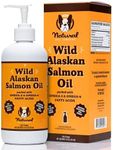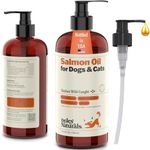Buying Guide for the Best Salmon Oils For Dogs
Choosing the right salmon oil for your dog can make a big difference in their overall health, from a shinier coat to better joint support. When shopping for salmon oil, it's important to understand what makes one product different from another. By focusing on a few key specifications, you can find an oil that matches your dog's needs and lifestyle. Always consider your dog's size, age, health conditions, and preferences when making your choice.Source of SalmonThe source of the salmon used in the oil is important because it affects the purity and nutritional value of the product. Salmon oil can come from wild-caught or farmed salmon. Wild-caught salmon is often considered purer and richer in nutrients, while farmed salmon may have more contaminants or additives. If your dog has sensitivities or you want the highest quality, look for oils made from wild-caught salmon. For general use, either source can be suitable, but always check for information about the origin to ensure safety and quality.
Omega-3 ContentOmega-3 fatty acids, especially EPA and DHA, are the main beneficial components in salmon oil. These support your dog's skin, coat, joints, and heart health. The amount of omega-3s can vary between products, usually measured in milligrams per serving. Lower omega-3 content is fine for general maintenance, while higher levels are better for dogs with specific health needs like joint issues or skin problems. Choose a product with omega-3 levels that match your dog's health goals and consult your vet if you're unsure.
Purity and TestingPurity refers to how free the oil is from contaminants like heavy metals, toxins, or artificial additives. Some products are third-party tested for purity, which means an independent lab has checked them for safety. Oils with clear purity testing are safer, especially for dogs with sensitivities or health issues. If your dog is healthy and you trust the brand, basic purity may be enough, but for peace of mind or special health needs, look for oils with third-party testing and certifications.
Form (Liquid, Capsule, Pump)Salmon oil comes in different forms, such as liquid bottles, capsules, or pump dispensers. Liquids are easy to mix with food and are good for picky eaters, while capsules are convenient for precise dosing and less messy. Pump bottles make it easy to measure and pour. If your dog is fussy or you want convenience, choose the form that fits your routine and your dog's preferences.
Added IngredientsSome salmon oils have added vitamins, preservatives, or flavorings. While added vitamins can be beneficial, unnecessary additives or artificial flavors may not be ideal for sensitive dogs. If your dog has allergies or a sensitive stomach, look for pure salmon oil with minimal extra ingredients. For dogs needing extra nutrition, a product with added vitamins might be helpful, but always check the ingredient list to match your dog's needs.
Shelf Life and StorageShelf life tells you how long the oil will stay fresh and effective. Some oils need refrigeration after opening, while others are stable at room temperature. If you use the oil quickly, shelf life may not matter much, but for occasional use, a longer shelf life is better. Choose a product with storage requirements that fit your lifestyle and make sure you can use it up before it expires.







